This was published 5 years ago
In divided Sri Lanka, a perfect storm for Islamist terror to swoop
By Matt Wade and James Massola
Jakarta: Walls stained with blood, holy statues shattered, pews smashed and a roof in ruins.
The devastated interior of St Sebastian's church in Negombo is one of the defining images of a deadly wave of terrorist attacks that rocked Sri Lanka on Easter Sunday.
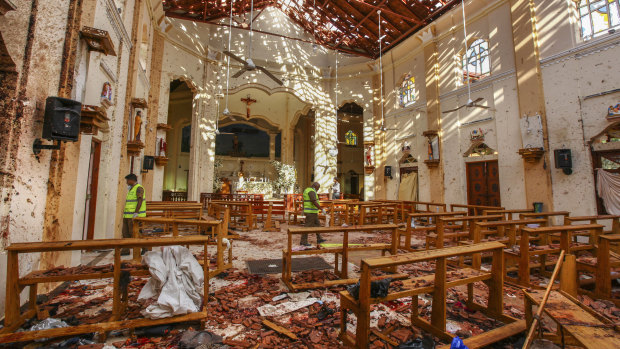
The destruction at St Sebastian's Church in Negombo, north of Colombo, Sri Lanka.Credit: AP
Security cameras captured the moment the suspected suicide bomber strode into the crowded Easter celebration at the largely Catholic seaside town north of the capital Colombo. A bearded man carrying a heavy grey backpack casually walks across the cobblestoned front yard and along a porch before entering a side door and striding into the heart of the crowded building.
More than 100 worshippers were killed by the blast, including Australian Manik Suriaaratchi and her 10-year-old daughter, Alexendria.
The massacre at St Sebastian's was just one part of a coordinated assault across three cities. Suicide bombers also hit St Anthony's Shrine in Colombo and Zion Church at Batticaloa in north-eastern Sri Lanka, along with three luxury hotels in Colombo - the Shangri-La, Cinnamon Grand and Kingsbury. The hotels were attacked as guests gathered in the restaurant for breakfast.
Six of the blasts occurred between 8.45 and 9.30am. There was a seventh at a Colombo guesthouse several hours later.
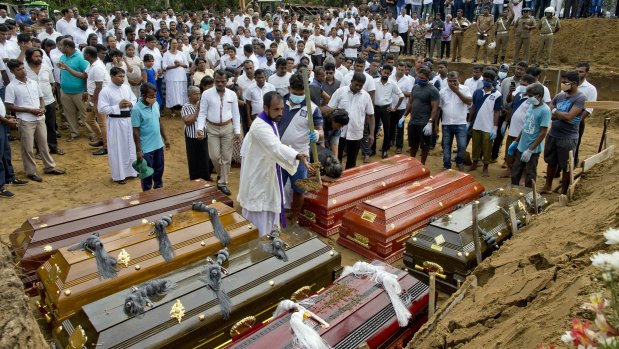
A mass burial for Easter Sunday attack victims in Negombo on Wednesday.Credit: AP
By Friday the official death toll was 253, having been revised down by about 100 from earlier estimates. Officials said the chaos at the bomb scenes had made the identification process challenging. "There are so many body parts and it is difficult to give a precise figure," said one.
Another 500 people were reported injured, including two Australian women.
Tensions have remained high in Colombo. As well as controlled detonations and nation-wide curfews imposed during the week, on Thursday there were warnings that at least two potential suicide bombers were at large and further attacks were possible. The names and photographs of six people wanted over Sunday's bombings were released and security was tightened across the city as police searched for suspects.
The shocking scale of the Easter Sunday atrocity exposes potential security threats across the whole region. There are warnings these attacks herald a new brand of terrorism.
A new type of terror
Sri Lanka is all too familiar with political violence. Conflict between the Sinhalese-speaking majority, which is mostly Buddhist, and the minority Tamil community fuelled a decades-long civil war which came to a bloody end in 2009. During the war the separatist Tamil Tigers staged more than 100 suicide attacks across the country. But the Easter assault - which targeted Sri Lanka's minority Christian community and Western tourists - did not fit that frame.
On Monday Sri Lankan officials said a little-known radical Islamist group, National Thowheeth Jamaath, had carried out the attacks, with help from international militants. The small outfit, which originated about a decade ago on Sri Lanka's east coast, was last year blamed for defacing Buddhist statues but has no previous history of staging large-scale terrorist attacks.
A day later, the Islamic State group issued a statement claiming responsibility, although Sri Lankan authorities said its exact role remains unclear. The group's propaganda arm described the bombers as "Islamic State fighters" and posted a video of eight people — apparently the Sri Lanka attackers — pledging allegiance to IS.
Brahma Chellaney, professor of strategic studies at New Delhi's Centre for Policy Research, says the country now faces a major new terrorism problem. "Sri Lanka has dealt with Tamil separatist violence but has had no experience handling Islamist terrorism," he said.
On Wednesday another disturbing link to Australia emerged – one of the suicide bombers had been a postgraduate student at Melbourne's Swinburne University. Abdul Lathief Jameel Mohamed, 36, died when he detonated his suicide bomb on Sunday at the New Tropical Inn guesthouse in Colombo, killing himself and two others. It appears he intended to bomb the luxury Taj Samudra hotel but the explosive device failed.
Samsul Hidaya, one of Mohamed's sisters, told the UK's Daily Mail her brother became "a different man" in Australia and returned more religious, withdrawn and intense.
Prime Minister Scott Morrison confirmed the man had lived in Australia with his wife and child on a student visa but left the country in 2013.
Authorities say many of the suicide bombers were highly educated and came from well-to-do families. Among them were two sons of wealthy Colombo spice trader, Mohammed Yusuf Ibrahim, who is now in custody. The brothers, Inshaf and Ilham Ibrahim, blew themselves up in the restaurants of separate hotels around 9am on Sunday.
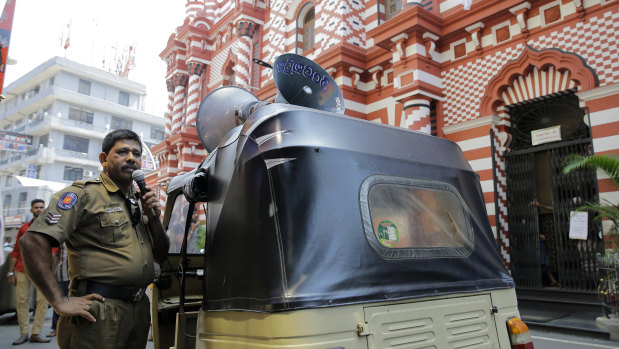
A Sri Lankan police officer announces security warnings outside Colombo's Red Mosque this week.Credit: AP
When police raided a mansion owned by the Ibrahim family in an exclusive part of Colombo on Sunday, a woman believed to be Ilham Ibrahim's pregnant wife also detonated a bomb, killing herself, her two children and three police officers.
More than 60 people have already been arrested over the attacks. Authorities also blocked social media services including Facebook, YouTube, WhatsApp, Instagram and Snapchat following Sunday's atrocities in a bid to stop the circulation of false information and reduce the risk of further violence.
Security lapses
The Sri Lankan government has been under pressure for failing to act on detailed warnings sent earlier this month that suicide attacks on churches were imminent. India's main intelligence agency, the Research and Analysis Wing, reportedly sent as many as three alerts to Sri Lanka, including one a few hours before the Easter Sunday bombings.
Sri Lankan President Maithripala Sirisena is responsible for security matters and the country's Prime Minister, Ranil Wickremesinghe, has indicated he didn’t receive the warnings.
Deep rifts within the Sri Lankan government may have contributed to security failures. Late last year Sirisena triggered a political crisis when he tried to oust Wickremesinghe, who is from a rival political party.
Deakin University professor Greg Barton says the tensions between Sirisena and Wickremesinghe had contributed to the attack taking place.
"This was a perfect storm exploited by Islamic State," he said. "[Sri Lankan authorities] weren't listening to India, they weren't sharing intelligence between agencies, and they were so fixated on the Tamil Tigers.
"But 30 to 40 Sri Lankans had gone to Islamic State, to Syria, the group involved had hitherto been known as a hateful extremist group rather than a violent one, and they have gone from attacking Buddhist statues to this attack."
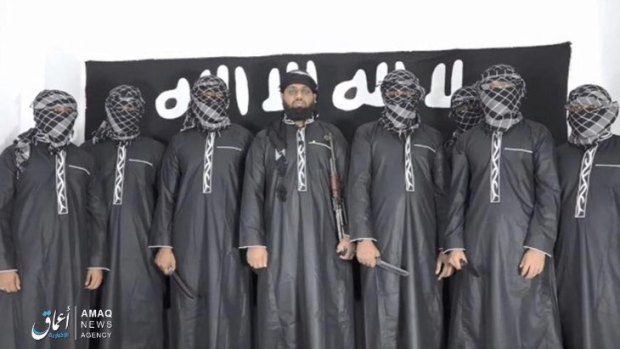
An image supplied by Islamic State's Amaq propaganda arm purports to show those behind the Easter Sunday attacks.
Nitin Pai, the director of the Bangalore-based Takshashila Institution think tank, says the Sri Lanka attacks, like last month's mosque shootings in Christchurch, New Zealand, foreshadows a new form of terrorism where the terrorists, the targets or both have little to do with the politics of the country where the attacks occur.
"The local group suspected of carrying out the attacks had few grievances against the local Christian community," he said. "Their action was in pursuit of the agenda of a foreign organisation [IS] that had a global agenda."
While the perpetrators were from Sri Lanka, the attacks do not make sense in the context of the island's domestic politics.
This was also the case in Christchurch, says Pai. He labels this "third-party terrorism" and warns it will be difficult and costly to combat: "Such terrorists could choose a country merely because it offers easier opportunities for attacks."
A region at risk
The attacks in Sri Lanka also raise questions about similarities and differences with other recent IS-inspired or linked attacks in South and South-east Asia. Two examples that stand out are the May 13, 2018 suicide bombings in the Indonesian city of Surabaya and the January 27, 2019 bombing of the Our Lady of Mount Carmel cathedral in the Philippines' city of Jolo.
The five bombings in Surabaya – three churches and a police station were hit, while a bomb also exploded in an apartment during a police raid – were carried out by the IS-inspired Jemaah Anshorut Daulah and killed 28 people. Indonesian police have stated that three families carried out the attacks, with the youngest attacker being a nine-year-old girl.
The Jolo attack killed 23 people and is thought to have been carried out by an Indonesian couple working with a pro-IS faction of the Abu Sayyaf group – though the nationality of the attackers is disputed and still being investigated. The woman involved detonated the first bomb inside the church, while her husband blew himself up seconds later at the church's entrance.
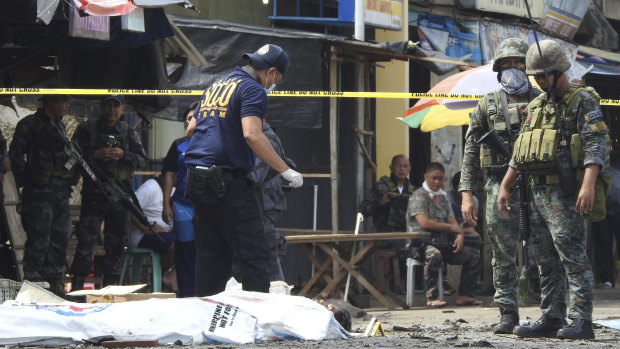
Police investigators examine the site after the January bombings in Jolo, Philippines.Credit: AP
In both cases, churchgoers and security forces were killed and many more people injured – but the scale of each operation was considerably smaller.
There are other key differences, such as geopolitical factors, that distinguish the attack in Sri Lanka from recent IS-inspired terrorism in South-east Asia.
Sidney Jones, from the Jakarta-based Institute for Policy Analysis of Conflict, says the Indonesia and Philippines cases were "small potatoes" compared to Sri Lanka "in terms of the planning and the competence and the professionalism".
"The thing that distinguishes South-east Asia from South Asia is that you don’t have regional politics in play. In South Asia, whenever something comes up involving an Islamist terrorist group, you have to immediately think of which neighbour is undermining whom," says Jones, one of the foremost experts on Islamist extremism in South-east Asia.
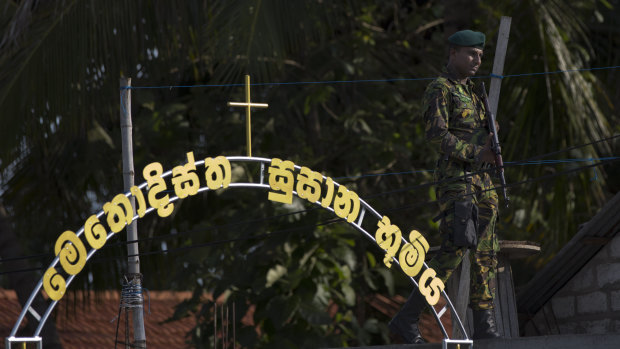
A Sri Lankan special task force officer stands guard in Negombo in the aftermath of the Easter Sunday attacks.Credit: AP
"Pakistan and India are always at play in some of these issues – immediately India or Sri Lanka might blame Pakistan, for example."
"That doesn’t operate in the South-east Asia context. No one is interested in assisting these extremist groups [to] improve their skills. No government in the region is interested in undermining one of its neighbours."
Barton says the attacks in Sri Lanka were the biggest by IS anywhere because of the death toll, the scale and the complexity involved in carrying them out. "Most of the attacks we have seen in recent years have been lone actors, one or two people, in Nice, London, Orlando," he says.
But Barton says there is a parallel between the attacks in Sri Lanka and the attack in Surabaya in that "it seems be one extended family network [that carried out the killings], probably communicating face-to-face and off the grid.
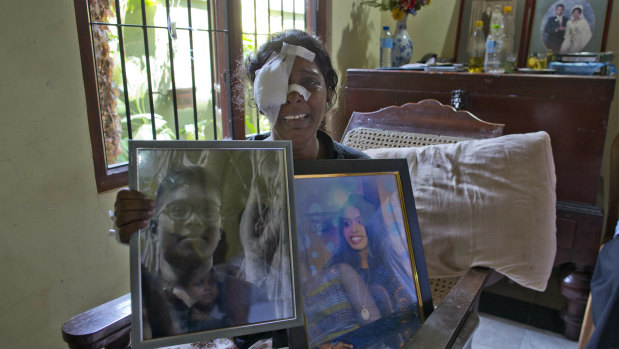
Anusha Kumari holds portraits of her daughter Sajini Venura Dulakshi and son Vimukthi Tharidu Appuhami, both victims of Easter Sunday's bomb blast in Negombo. Her husband was also killed in the attack.Credit: AP
"But the big parallel is with Dhaka in 2016, the Holey Artisan bakery attack [in which 22 people were killed]. That had equipment, logistics and training from Islamic State, at one remove, and was an audacious military-style assault, with hostages and executions."
Bangladeshi authorities, Barton says, had convinced themselves they didn't face a threat from Islamist terrorism – much as Sri Lankan authorities had done.
"Both Bangladesh and Sri Lanka faced a threat from local extremists being amplified in their capacity by international networks and they were insistent on saying their problems were local only and of limited severity. But in fact in both cases there was an Islamic State presence which was consequential in the scale and intensity of the attacks that were launched," he adds.
Barton says that Indonesia is very different to Sri Lanka or Bangladesh as it has acknowledged it has a local support network for IS and has had them under intense scrutiny.
"Indonesia actually has a lot of capacity, Detachment 88 [a crack counter-terrorist unit formed after the 2002 Bali bombing] has arrested more than 1400 people. They are very good at intelligence," he says.
The Philippines is different again, as it had been reluctant to acknowledge the growing allegiance to IS that some of its extremists had. The siege of the southern city of Marawi in May 2017 forced the government to acknowledge the problem posed by extremists to Islamic State was much bigger, "but they still don't have the capacity to deal with it as Indonesia does".
Barton says the attacks are a reminder that the "reality is that this global insurgency of Islamic State is a real thing and it will be with us for a while longer".
Barton expresses concerns that Malaysia and Thailand could also be vulnerable. "One of the places where we should be concerned is Malaysia. Malaysia, like Bangladesh, says it has things under control but the reality is they may not. They have a very good special branch section in their national police. That lack of incidents there is because of special branch. The question is how long can that be the case?"
In Thailand, which has three restive majority-Muslim provinces on its southern border with Malaysia, "it's also quite possible we could see repeated in Bangkok or Chiang Mai the sort of attacks we saw in Sri Lanka. The idea is that there isn't jihadis in the centre or the north of the country. So there is a real risk in terms of a rude awakening."
David Brewster, a specialist in Indian Ocean regional security at the Australian National University's National Security College, said the Easter Sunday attack emphasised how important it is for Australia to engage with Sri Lanka and its neighbours.
"Australia has a very important role to play in helping to provide security and stability in our neighbourhood," he said.
"We need to be building our relationship with countries such as Sri Lanka and Bangladesh, not stepping back."